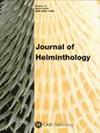TO小鼠原发性Heligmosomoides polygyrus感染的强度和持续时间会改变获得性免疫对继发挑战的影响
IF 1.3
3区 生物学
Q4 PARASITOLOGY
引用次数: 0
摘要
在雌性TO小鼠中研究了多钩端螺旋体免疫感染的剂量和持续时间对同源挑战保护的影响。用吡蚜酮(成虫感染)或伊维菌素(幼虫感染)终止不同程度的初次感染,然后用500头感染性幼虫(L3)对小鼠进行挑战。对二次挑战的保护水平与初次免疫感染的强度呈正相关,但幼虫感染的截断所产生的保护效果明显优于线虫成虫感染的终止。幼虫一次感染的持续时间(1-6 天)与二次感染的保护水平、抗体反应和循环中嗜酸性粒细胞的比例呈正相关。小鼠胃肠道的组织学变化、外周白细胞变化以及对多角体吸虫成虫体细胞抗原的抗体反应表明,宿主对二次感染的免疫力既有细胞免疫基础,也有体液免疫基础。尽管多瘤病毒小鼠的反应较慢,会出现慢性感染,但通过粘膜内杀死幼虫阶段进行免疫,可对二次挑战感染产生很强的保护作用。肠壁内存在死亡的免疫原性幼虫阶段很可能是一个重要因素,因为它使宿主在适当的位置接触到阶段特异性抗原。本文还讨论了这些发现对控制胃肠道线虫感染的影响。本文章由计算机程序翻译,如有差异,请以英文原文为准。
The intensity and duration of primary Heligmosomoides polygyrus infection in TO mice modify acquired immunity to secondary challenge
The effect of dose and duration of immunizing infections of Heligmosomoides polygyrus on protection against homologous challenge was studied in female TO mice. Primary infections were terminated at various levels with pyrantel embonate (adult infections) or ivermectin (larval infections) and mice were then challenged with 500 infective larvae (L3). The level of protection to secondary challenge positively correlated with the intensity of the primary immunizing infection but truncation of larval infection produced significantly better protection than termination of the adult nematode infection. The duration of the primary larval infection (1–6 days) positively correlated with the level of protection to secondary challenge, antibody responses and the proportion of circulating eosinophils. Histological changes in the gastrointestinal tract, peripheral leucocytic changes and antibody responses of the mice to H. polygyrus adult somatic antigens indicate both a cellular and humoral basis of host immunity to secondary challenge. Although the TO mice are slow responders in that they harbour chronic infections, immunization by intramucosal killing of the larval stage produced strong protection against secondary challenge infection. The presence of dead immunogenic larval stages within the intestinal wall may well be an important factor, since it exposes the host to stage specific antigens at an appropriate location. The implications of the findings for the control of gastrointestinal nematode infections are also discussed.
求助全文
通过发布文献求助,成功后即可免费获取论文全文。
去求助
来源期刊

Journal of Helminthology
生物-动物学
CiteScore
2.80
自引率
12.50%
发文量
127
审稿时长
3 months
期刊介绍:
Journal of Helminthology publishes original papers and review articles on all aspects of pure and applied helminthology, particularly those helminth parasites of environmental health, medical or veterinary importance. Research papers on helminths in wildlife hosts, including plant and insect parasites, are also published along with taxonomic papers contributing to the systematics of a group. The journal will be of interest to academics and researchers involved in the fields of human and veterinary parasitology, public health, microbiology, ecology and biochemistry.
 求助内容:
求助内容: 应助结果提醒方式:
应助结果提醒方式:


